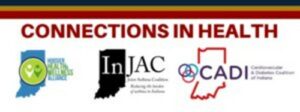
Washington County is the fourth featured county highlighting the benefits of the Connections IN Health community engagement project. After multiple community listening sessions and 170 completed survey responses, Washington County stakeholders identified cardiovascular disease, diabetes and stroke as the leading health challenges faced by residents.
Heart disease is ranked as the leading cause of death in the county with 264 related deaths per 100,000 people – significantly higher than the state average, resulting in a primary area of focus for coalition partners in program implementation and a new media awareness campaign. Compounding the hurdles of health challenges, community readiness scores gathered by the Cardiovascular and Diabetes Coalition of Indiana, a Connections IN Health initiative, indicated a low awareness of available local resources to assist in diet and nutrition education that directly associate with cardiovascular disease. There were also fewer opportunities to access health and fitness centers compared to other communities, leading to higher statistics of physical inactivity and obesity that can contribute to heart diseases.
“This led us to focus on a county-wide awareness and education campaign,” said Aliya Amin, MPH, Washington County lead for the coalition. “Our research found we had a lot of programs going on, but not a lot of people showing up to take advantage of them. The perception is that we could be doing more, and that’s where we want to focus.”
The coalition is using its $10,000 allocation to Washington County to build awareness of programs that already exist with the goal of increasing engagement. Funds are also being used for financial assistance for nutrition education classes, creation of walking and biking programs on local trails, a high school wellness program to promote healthy living at a younger age, YMCA health and wellness initiatives, school summer food program and after-school snacks.
The Purdue Extension, one of the county coalition partners, is also leading the Dining with Diabetes and Be Heart Smart programs beginning in February. There are several opportunities throughout the year to attend the programs:
Be Heart Smart Program
February 7 in Salem, Indiana, and April 4 in Hardinsburg, Indiana
Be Heart Smart aims to raise awareness of heart healthy food, cooking demonstrations, recipes and education abound learning and understanding your numbers to empower residents to live their healthiest lives.
“Physicians may share numbers like blood pressure and cholesterol levels with their patients, but they don’t discuss enough what they mean and how to get them to healthy levels,” said Sonya Mitchell, health and human sciences educator with Purdue Extension. “These numbers count; they tell you something. The more you know, the better prepared you are to make healthy choices.
“It’s not as hard as most people think when you understand how to make healthy choices and why. Small changes can make a big difference.”
Dining with Diabetes Program
May 9 in Salem, Indiana
Dining with Diabetes is a four-week program educating residents about diabetes, what blood sugar level numbers mean and why they can change over time. The program includes healthy cooking demonstrations and recipes specifically for preventing and managing diabetes.
“We hope that by demonstrating how easy the recipes are to make and that they taste good, it will encourage people to try more healthy foods and fewer fast-foods,” Mitchell said. “A lot of times, people think eating healthier is about restrictions – what you can’t have versus what you can – but it’s not.”
The group gathers again three months after they have completed Dining with Diabetes to check in, address follow-up questions and reinforce smart steps to making healthy lifestyle changes.
Katelyn Kutemeier, community wellness coordinator for the Purdue Extension Nutrition Education Program, said the challenge now is getting the message out to the public about the diversity of both existing and new programs. A new community awareness campaign will begin this year that includes distribution of information mailers, paid advertising and posting to social media platforms using the strength of trusted small groups and neighbor-to-neighbor connections.
“The coalition organizations really help build the foundation for these programs that can grow in our communities here and across the state,” Amin said. “That’s the real strength of our project, and we hope to see an increase in program participation numbers by getting more people engaged with what’s close by in their own backyard.”
Washington County has a large number of community members who want to be healthy, Kutemeier said.
“Sometimes, they just don’t know they have the resources,” she said. “We are excited to fill this gap for them and for our education program to compliment the marketing program.
“There’s a lot of work that has gone behind these programs, and this is just the beginning of making strides in the health and wellness of Washington County residents.”
Look for future stories on county engagement efforts in the coming months. Learn more about how the county engagement project got started. Also read about Vermillion County, Grant County and Blackford County community efforts that were featured in earlier editions.
